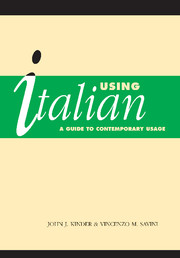Book contents
- Frontmatter
- Contents
- Preface and acknowledgments
- Abbreviations
- 1 Varieties of language
- WORDS AND THEIR MEANINGS
- 2 Misleading similarities
- 3 Fields of meaning – “Synonyms”
- 4 Complex verbal expressions
- 5 Affective suffixes
- 6 Idioms, similes, and proverbs
- 7 Personal names
- 8 Geographical and astronomical names
- 9 Abbreviations and acronyms
- 10 Latin expressions and sayings
- 11 Grammatical terms
- 12 Numerals and telephone conventions
- 13 Measurement
- THE CLAUSE – combining words
- THE SENTENCE – combining clauses
- TEXTS AND THEIR STRUCTURE
- Bibliography
- Italian word index
- Grammar index
12 - Numerals and telephone conventions
Published online by Cambridge University Press: 05 June 2012
- Frontmatter
- Contents
- Preface and acknowledgments
- Abbreviations
- 1 Varieties of language
- WORDS AND THEIR MEANINGS
- 2 Misleading similarities
- 3 Fields of meaning – “Synonyms”
- 4 Complex verbal expressions
- 5 Affective suffixes
- 6 Idioms, similes, and proverbs
- 7 Personal names
- 8 Geographical and astronomical names
- 9 Abbreviations and acronyms
- 10 Latin expressions and sayings
- 11 Grammatical terms
- 12 Numerals and telephone conventions
- 13 Measurement
- THE CLAUSE – combining words
- THE SENTENCE – combining clauses
- TEXTS AND THEIR STRUCTURE
- Bibliography
- Italian word index
- Grammar index
Summary
Numerals and mathematical conventions
Decimals
In Italian, as a rule, the punto (point) separates thousands, the vìrgola (comma) decimals, e.g. 1.000.000 = un milione; 23,42 = ventitré virgola quarantadue/ventitré e quarantadue (centesimi). note that the English reading twenty-three point four two has no direct equivalent in Italian (ventitré virgola quattro due is not used). However, it should be pointed out that the use of the decimal point, if not practiced, is certainly widely understood in Italy, especially in the scientific world.
For the sake of clarity, the Anglo-American conventions (i.e. decimal point) have been applied throughout this text, even in Italian contexts.
Mathematical operations
When doing operations, the following Italian expressions are worthy of notice:
in sums (addizioni), in everyday casual speech “plus” can be simply e, and “equals” is omitted, e.g. 2 + 3 = 5 due e tre cinque (R1–2), rather than due più tre è uguale a (R2–3)/fa cinque. Cf. the idiom in quattro e quattr'otto (“in the twinkling of an eye”).
in divisions (divisioni), “divided by” becomes diviso, e.g. 8 : 2 = 4 otto diviso due è uguale a (R2–3)/fa quattro
in ratios (proporzioni), English “is to” becomes Italian sta a, e.g. 4 : 6 = 6 : 9 quattro sta a sei come sei sta a nove
in raising to a power (elevazione a potenza), “squared” is translated al quadrato, “cubed” al cubo, and, generally, “to the nth power” becomes all'ennesima (potenza), e.g. 33tre al cubo/alla terza (potenza)
- Type
- Chapter
- Information
- Using ItalianA Guide to Contemporary Usage, pp. 226 - 228Publisher: Cambridge University PressPrint publication year: 2004



